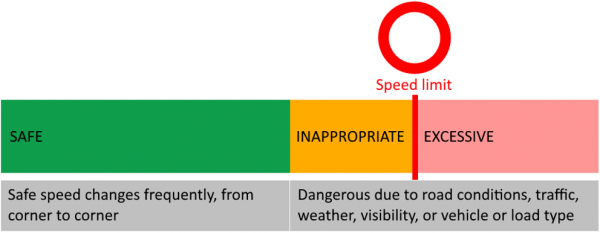Excessive speed is where a driver exceeds the posted speed limit. For example, if the limit is 50km/h and the driver drives at 60km/h, this is excessive speed.
Inappropriate speed is where the driver drives within the speed limit, but not for the conditions of the road. An example would be a driver that drives at 90km/h on a rural road in thick fog.
Excessive speed is above the speed limit, while inappropriate speed is below the speed limit but still dangerous.

Both inappropriate and excessive speed can cause loss-of-control accidents causing the driver to run off the road.
There are situations where inappropriate speed does not exist. For example, on a motorway in clear weather with light traffic, the safe speed is up to 100km/h and excessive speed starts at 101km/h.
What is safe speed?
Safe speed is a speed at which the vehicle can cope with the conditions and the driver is able to pilot the vehicle without causing undue danger to other road users (or themselves).
Safe speed changes constantly. Every time the road conditions change, the safe speed changes. A sharp corner will cause the safe speed to drop. Rain, fog, ice and sunstrike all cause the safe speed to drop.
How do you judge a safe speed?
Safe speed is determined by:
- Your vehicle’s capabilities
- Your capabilities
- The weather
- Visibility of the road (i.e. how far you can see ahead)
- The road’s surface
- The characteristics of your path (i.e. sharp turns, blind crests, dips, etc)
- Other road users (e.g. horse riders, cyclists)
Safe speed doesn’t just apply on the road, it applies to forklifts in warehouses and machinery used off-road.
